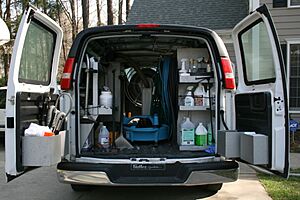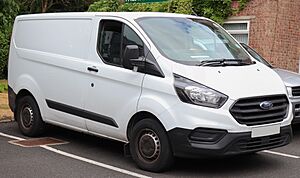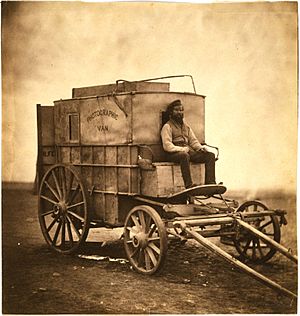Van facts for kids
A van is a type of road vehicle used for carrying things or people. Vans can be different sizes. Some are bigger or smaller than pickup trucks and SUVs. They are usually bigger than a regular car. The smallest vans are called microvans. They carry small amounts of goods or a few people. Other small vans like Mini MPVs and MPVs are often used to carry a small number of passengers. Larger vans with seats are used by schools to transport students. Big vans with only front seats are often used by businesses to carry goods and equipment. Special vans are even used by TV stations as mobile studios! Postal services and delivery companies use large vans to deliver packages.
Contents
What's in a Name? The Word "Van"
The word "van" is actually a shorter version of the word "caravan." Long ago, a caravan meant a group of wagons traveling together. Later, it also meant just one covered wagon used for carrying goods. The first time "van" was used to mean a vehicle was in the mid-1800s.
The word "van" can mean slightly different things in different English-speaking countries. But generally, it always refers to a boxy vehicle for cargo. Let's look at some examples:
Vans Around the World
In Australian English, "van" often means a minivan or a passenger minibus. It can also mean a special type of van called a panel van, made by companies like Holden. Sometimes, Australians even use "van" to mean a "caravan," which is like a travel trailer in the U.S.
In India, vans are very common. They are often used to take school children to and from school. Many businesses also use vans for deliveries or as office cabs. Popular vans in India include the Maruti Suzuki Omni and the Maruti Suzuki Eeco.
In Japan, early vans included the Kurogane Baby and Mazda Bongo. Japanese companies also make many minivans. Small vans that fit special "kei car" rules are popular for small businesses. The word "van" in Japan can also describe station wagons or even hatchbacks that are used for commercial purposes.
In British English, "van" usually means a vehicle that only carries goods. What Americans call a "minivan" is called a "people-carrier" or "MPV" (multi-purpose vehicle) in the UK. Larger passenger vans are called "minibuses." The term "White Van Man" is used to describe a typical small business owner who drives a white van like a Ford Transit.
In the United States, a "van" can also mean a box-shaped trailer pulled by a truck. These are used to carry goods. There are "dry vans" for most goods and "refrigerated vans" (or "reefers") for cold items. A railway car that carries luggage is also called a "van."
How Vans Have Changed: A Brief History

Before modern vans, there were "sedan deliveries" in the U.S. from the 1930s to the 1950s. The first real American vans appeared in the 1960s. These were "compact vans," similar in size to the Volkswagen Bus. Some early models, like the Chevrolet Corvair-based van, even had their engines in the back.
Later, companies like Ford changed the design. They moved the engine to the front, under a short hood. These became the "standard" or "full-size" vans we know today. Over time, these vans got longer noses and smoother shapes. Many vans are sold as cargo vans, passenger vans, or as "cutaway van chassis." These cutaway versions are then finished by other companies to become recreational vehicles, school buses, ambulances, or delivery trucks.
What Are Vans Used For?

Vans are used in many ways! In cities, large vans have been used as "commuter vans" since the 1970s. These vans help people share rides to work, reducing traffic.
Many businesses use vans to carry all their tools and supplies. This lets them do their work right at people's homes or businesses. For example, plumbers, electricians, and carpet cleaners often use vans. Vans also shuttle people and their luggage between hotels and airports. They transport people from parking lots to their workplaces. Churches use vans to take elderly people to services or youth groups on outings. Schools use vans to drive sports teams to games. Even music bands use vans to carry their equipment and travel to concerts!
Full-Size Vans
A "full-size van" is a marketing term in North America for a van that is larger than a minivan. They look big and boxy, have a short hood, and can carry a lot of cargo or many passengers.
The first full-size van was the 1969 Ford Econoline. It used parts from Ford F-Series pickups. Other companies like General Motors and Dodge soon made their own versions. Today, popular full-size vans include the Mercedes-Benz Sprinter, Ford Transit, and Chevrolet Express.
Step Vans
Another type of van, mostly found in North America, is the "step van." It's called this because it's easy for drivers to step in and out quickly. Delivery services like FedEx and the US Postal Service use them a lot. Step vans are very boxy, wide, and tall. They are almost never used for carrying passengers. The Chevrolet Step-Van is a well-known example.
Minivans
A Minivan is smaller in length and height than a full-size van. Minivans are often used by families for personal travel. They are also used as taxis or shuttles, and for delivering mail or packages. Minivans offer more cargo space than regular sedans and SUVs. They also have a lower center of gravity, which helps with handling and makes them less likely to roll over.
Some popular minivans include the Honda Odyssey, Toyota Sienna, and Chrysler Pacifica.
Staying Safe in Vans
Vans are taller than regular cars, which means they have a higher center of gravity. This can make them more likely to roll over in certain situations. Also, a van carrying 15 passengers can be very heavy!
To stay safe, it's very important for everyone in a van to wear their safety belt. The U.S. National Highway Traffic Safety Administration (NHTSA) says that people wearing seatbelts are about four times more likely to survive a rollover crash.
Drivers of 12- and 15-passenger vans should understand how these vehicles handle differently. Following safety guidelines can help keep everyone safe.
Safety Equipment in Vans
Many commercial vans have "cargo barriers" installed behind the front seats. These are strong walls that stop items in the back from flying forward if the van stops suddenly, crashes, or rolls over. This helps protect the driver and passengers from injuries caused by loose cargo. Sometimes, these barriers even have doors so the driver can get to the cargo area from the front.
See also
 In Spanish: Furgoneta para niños
In Spanish: Furgoneta para niños
- Campervan
- Ice cream van
- Kebab van
- List of vans
- Public light bus
- Sedan delivery
- Box truck





